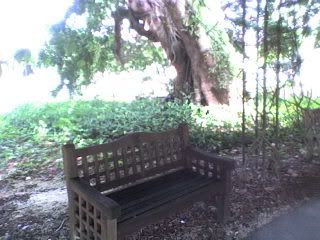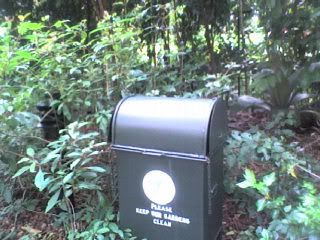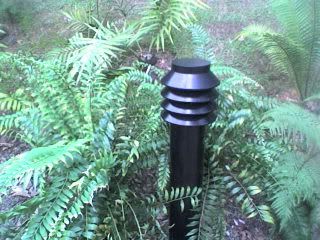 This picture portrays a bench situated under a shelter that is being covered by creepers and climbers and in addition, there are also several huge and sturdy trees surrounding the shelter though they cannot be seen in this picture. From here, it can be seen that man has made use of nature in one way or another in seek of comfort. In this case, man has constructed the shelter and the bench out of a natural resource – wood, which was originally part of a tree, part of Mother Nature. Man has also intentionally positioned the bench under these trees and non-woody plants as they can provide a cooling and shady resting area that shields the visitors from the scorching sun. Though it is justifiable to say that man has taken advantage of nature, the creepers and climbers are also heavily reliant on the man-made structure for survival. Thus, an interdependent relationship between man and nature is prevalently illustrated here.
This picture portrays a bench situated under a shelter that is being covered by creepers and climbers and in addition, there are also several huge and sturdy trees surrounding the shelter though they cannot be seen in this picture. From here, it can be seen that man has made use of nature in one way or another in seek of comfort. In this case, man has constructed the shelter and the bench out of a natural resource – wood, which was originally part of a tree, part of Mother Nature. Man has also intentionally positioned the bench under these trees and non-woody plants as they can provide a cooling and shady resting area that shields the visitors from the scorching sun. Though it is justifiable to say that man has taken advantage of nature, the creepers and climbers are also heavily reliant on the man-made structure for survival. Thus, an interdependent relationship between man and nature is prevalently illustrated here.As mentioned above, the creepers and climbers has to rely on the man-made shelter to survive and without man’s intervention, these plants would be regarded as sheer weaklings. Thus, man has control over the lives and fates of these creepers and climbers. While the shelter is firm and strong, these plants are weak and do not even possess the ability to stay upright on its own. In this contrast, nature can be seen as a weakling that man can effortlessly execute manipulation over and that nature succumbs to man easily.
Though the shelter and bench are constructed by man, nature plays a crucial role too. The man-made bench and shelter are able to blend perfectly into the context of the picture and do not look out of place due to the fact that they are made of wood which was originally part of nature. This implies that man can actually coexist with nature as one united entity. Without the raw material provided by nature, these man-made structures would not have existed. It is right to say that both the bench and shelter are man-made, but after all it is nature that granted them life. Thus, with the shelter that is made out of nature over man’s head, this signifies the eventual triumph of nature over mankind and his evil doings and harms done to nature. In addition, the shadow of the shelter cast on man signifies the state of misery and darkness mankind will suffer if one continues to exploit nature. On the contrary, a large tree in the background of the picture is brightly lit by the sunlight. This, on one hand suggests that nature will eventually emerge victorious in the battle with mankind and on the other, signifies that nature is sacred and holy which man should show respect to.
 This photograph shows a rubbish bin with lush green plants surrounding it. Though the rubbish bin is also of green color, with the intention to enable the rubbish bin to fit and blend into the surroundings, the rubbish bin still look out of place. The plants and the rubbish bin just do not match well together as the plants are vibrant and generate a sense of life while the latter seems so rigid and lifeless. This shows that man is simply out of tune with nature. Though situating a rubbish bin amongst the plants may seem to be an eyesore, it is definitely much better than having pieces of unsightly litters amongst the plants.
This photograph shows a rubbish bin with lush green plants surrounding it. Though the rubbish bin is also of green color, with the intention to enable the rubbish bin to fit and blend into the surroundings, the rubbish bin still look out of place. The plants and the rubbish bin just do not match well together as the plants are vibrant and generate a sense of life while the latter seems so rigid and lifeless. This shows that man is simply out of tune with nature. Though situating a rubbish bin amongst the plants may seem to be an eyesore, it is definitely much better than having pieces of unsightly litters amongst the plants.Man’s evil doings and harm done to the environment in the midst of modernizing has already incurred the wrath of Mother Nature and that nature has started to express her discontentment in the forms of natural disasters and climate changes in many parts of the world. Thus, the rubbish bin is there for an essential purpose. It is an attempt by man to maintain the hygiene of the environment which shows man’s concern over nature. By placing a rubbish bin there, it is it is actually man’s effort to conserve and protect nature from further land pollution and harm inflicted in hope of appeasing Mother Nature.
 This image shows a lamp being surrounded by green plants. The lamp seems to be out of place in this natural setting. The metallic black of the lamp looks cold and dull while the green color makes the plant seem to be full of vitality. As normal plants grow, the leaves will tend to arrange themselves around the stem in a systematic way that optimizes the amount of sunlight received. However, in the case of this picture, instead of the regular manner in which the plant should develop, man’s intervention has caused the abnormal development of the plants. Perhaps the lighting is there to enhance the beauty of the plants especially during the night, but the lack of space due to the obstruction of the lamp has already caused overlapping of the leaves and curvatures and bends present in the plants, which inevitably destroyed the plant’s natural beauty. The growth and freedom of the plants are being suppressed by the man-made lamp. The defiant plants seem to be fighting for the space that is rightful to them and pushing against the lamp with all their might, but to no avail. The lamp continues to stay firm and upright. On the contrary, while the plants’ resistance to the lamp is negligible, mankind can easily remove and clear large area of forests for commercial uses and farming purposes when there is a space constraint. Nature’s helplessness and vulnerability can be evidently seen here. This great contrast between the resistances posed by nature to man and vice versa, illustrates the dominance man has over nature.
This image shows a lamp being surrounded by green plants. The lamp seems to be out of place in this natural setting. The metallic black of the lamp looks cold and dull while the green color makes the plant seem to be full of vitality. As normal plants grow, the leaves will tend to arrange themselves around the stem in a systematic way that optimizes the amount of sunlight received. However, in the case of this picture, instead of the regular manner in which the plant should develop, man’s intervention has caused the abnormal development of the plants. Perhaps the lighting is there to enhance the beauty of the plants especially during the night, but the lack of space due to the obstruction of the lamp has already caused overlapping of the leaves and curvatures and bends present in the plants, which inevitably destroyed the plant’s natural beauty. The growth and freedom of the plants are being suppressed by the man-made lamp. The defiant plants seem to be fighting for the space that is rightful to them and pushing against the lamp with all their might, but to no avail. The lamp continues to stay firm and upright. On the contrary, while the plants’ resistance to the lamp is negligible, mankind can easily remove and clear large area of forests for commercial uses and farming purposes when there is a space constraint. Nature’s helplessness and vulnerability can be evidently seen here. This great contrast between the resistances posed by nature to man and vice versa, illustrates the dominance man has over nature.The plants in the picture look aggressive and untamed. Even though these plants do not have the mean to destroy or eliminate the lamp instantly, they will eventually emerge victorious as they grow and envelope the lamp. In our urban society, mankind is destroying nature, oblivious to that fact that nature has already been angered. The consequences of damaging nature are not immediate but will accumulate and eventually show in time to come which is precisely the idea that the picture wants to show. The consequences of our reckless damaging to the nature are already visible in many parts of the world such as the rising of sea levels and the earth’s temperature. Nature has a certain limit of tolerance to the damages inflicted by man upon her, and if man goes beyond that limit, the backlash from nature would solely be man’s fault.
Gui Yu Yang 2B'06





No comments:
Post a Comment